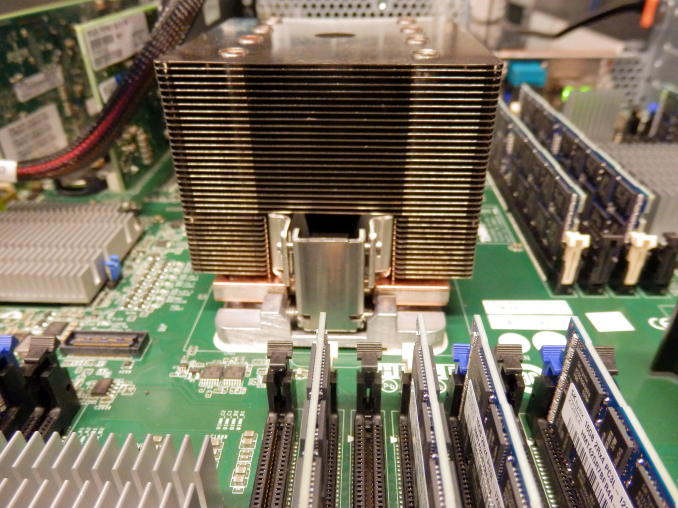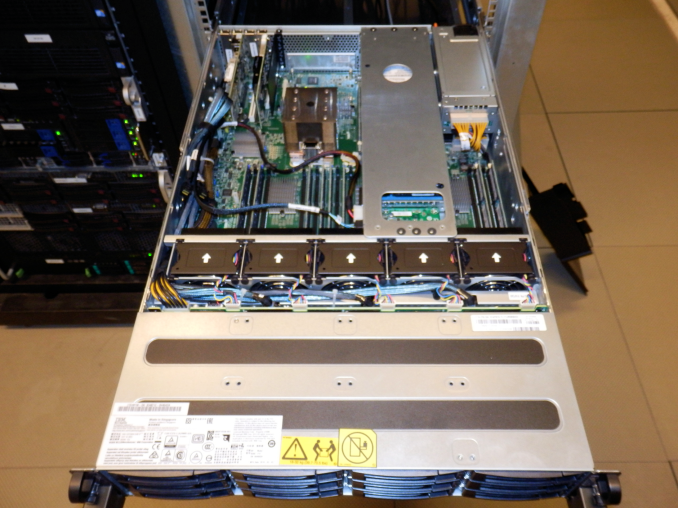Assessing IBM's POWER8, Part 1: A Low Level Look at Little Endian
by Johan De Gelas on July 21, 2016 8:45 AM EST
It is the widest superscalar processor on the market, one that can issue up to 10 instructions and sustain 8 per clock: IBM's POWER8. IBM's POWER CPUs have always captured the imagination of the hardware enthusiast; it is the Tyrannosaurus Rex, the M1 Abrams of the processor world. Still, despite a flood of benchmarks and reports, it is very hard to pinpoint how it compares to the best Intel CPUs in performance wise. We admit that our own first attempt did not fully demystify the POWER8 either, due to the fact that some immature LE Linux software components (OpenJDK, MySQL...) did not allow us to run our enterprise workloads.
Hence we're undertaking another attempt to understand what the strengths and weaknesses are of Intel's most potent challenger. And we have good reasons besides curiosity and geekiness: IBM has just recently launched the IBM S812LC, the most affordable IBM POWER based server ever. IBM advertises the S812LC with "Starting at $4,820". That is pretty amazing if you consider that this is not some basic 1U server, but a high expandable 2U server with 32 (!) DIMM slots, 14 disk bays, 4 PCIe Gen 3 slots, and 2 redundant power supplies.
Previous "scale out" models SL812 and SL822 were competitively priced too ... until you start populating the memory slots! The required CDIMMs cost no less than 4(!) times more than RDIMMs, which makes those servers very unattractive for the price conscious buyers that need lots of memory. The S812LC does not have that problem: it makes use of cheap DDR3 RDIMMs. And when you consider that the actual street prices are about 20-25% lower, you know that IBM is in Dell territory. There is more: servers from Inventec, Inspur, and Supermicro are being developed, so even more affordable POWER8 servers are on the way. A POWER8 server is thus quite affordable now, and it looks like the trend is set.
To that end, we decided that we want to more accurately measure how the POWER8 architecture compares to the latest Xeons. In this first article we are focusing on characterizing the microarchitecture and the "raw" integer performance. Although the POWER8 architecture has been around for 2 years now, we could not find any independent Little Endian benchmark data that allowed us to compare POWER8 processors with Intel's Xeon processors in a broad range of applications.
Notice our emphasis on "Little Endian". In our first review, we indeed tested on a relatively immature LE Ubuntu 14.04 for OpenPOWER. Some people felt that this was not fair as the POWER8 would do a lot better on top of a Big Endian operating system simply because of the software maturity. But the market says otherwise: if IBM does not want to be content with fighting Oracle in an ever shrinking high-end RISC market, they need to convince the hyper scalers and the thousands of smaller hosting companies. POWER8 Server will need to find a place inside their x86 dominated datacenters. A rich LE Linux software ecosystem is the key to open the door to those datacenters.
When it comes to taking another crack at our testing, we found out that running Ubuntu 15.10 (16.04 was just out yet when we started testing) solved a lot of the issues (OpenJDK, MySQL) that made our previous attempt at testing the POWER8 so hard and incomplete. Therefore we felt that despite 2 years of benchmarking on POWER8, an independent LE Linux-focused article could still add value.











124 Comments
View All Comments
nobodyblog - Thursday, July 21, 2016 - link
Please correct this error, you are saying you are comparing with BEST Intel can provide, but you did address Xeon for workloads need Xeon Phi Knight Landing which is a standalone CPU, too. If you choose correctly, the benchmark will be sooo different.IBM Power 8 is 90 GB/s, while Intel's Xeon phi knight landing (as 7290F) has a bandwidth of 400 GB/s.
IBM power 8 does above 600 gflops single precision and above 300 gflops double precision FLOPs, this is *10 in Xeon phi 7290F.
Specint: xeon phi is 1500 vs 1700 for power 8
Power and Price aside....
Thanks!
LukaP - Thursday, July 21, 2016 - link
If we start comparing different product categories, why not bring the GP100 into this as well. It will deliver 10TFLOPS of single precision and can be had for much less than any of these. But then again, there is the same caveat as the Xeon Phi. You cant actually run an OS on it, you need a host CPU and then you dispatch kernels onto the accelerator. Even if its a socketed version.smilingcrow - Thursday, July 21, 2016 - link
You can boot from newer Xeon Phi; either current or the next generation due maybe this year!LukaP - Thursday, July 21, 2016 - link
Oh really? :o that is neat, though not sure if that useful, since even highly parallel tasks usually have some IPC dependent components...Anyways have you got a source for that, would love to read more
Drumsticks - Thursday, July 21, 2016 - link
I'm a verification intern on the Phi team right now, and you can indeed boot Knight's Landing! Anandtech mentions it here: http://www.anandtech.com/show/9802/supercomputing-...nobodyblog - Friday, July 22, 2016 - link
Then you can add another xeon phi to above statistics... Xeon Phi KL is a CPU like other CPUs it does everything as mentioned even its specint is comparable, not so bad...Thanks!
tipoo - Friday, July 22, 2016 - link
Xeon Phi is x86, but it's GPU-like in nature, massively parallel for performance with low per-core performance. The IBM Power8 and other Xeons compete in highly parallel spaces like banking, but where single thread performance also still matters. Can't compare them.nobodyblog - Friday, July 22, 2016 - link
Xeon Phi Knight Landing has 3 times more single thread performance than silvermont (& knight corner).. I don't think it is so bad...The comparison is truly so, see the benchmarks, they say specint for example, or anything parallel performance, additionally, you can use a Xeon high performance with a xeon phi, there is nothing that prevents you. The benchmark is not about Database performance or parsing or anything similar, it is about this article, I don't say xeon phi is currently better positioned than xeon in these uses... But IBM's Power is not so, too, it has lots of core and lots of threads which is usable only in massive parallel uses...
Thanks!
nobodyblog - Friday, July 22, 2016 - link
On the IBM server, numactl was used to physically bind the 2, 4, or 8 copies of SPEC CPU to the first 2, 4, or 8 threads of the first core. On the Intel server, the 2 copy benchmark was bound to the first core. It is not single thread, it is a trick IBM uses to cheat in benchmarks, it is 425% percents slower than xeon in single thread.Thanks!
jospoortvliet - Tuesday, July 26, 2016 - link
The benchmarks here pit one core against one core. The IBM cores can run 1, 2, 4 or 8 threads on a single core, the Intel does 1 or 2. The 425%, not sure where that number comes from, but it isn't what shows out of these benchmarks.The benchmarks show, as described by Johan:
In single thread, the IBM does about 13% less work than the Intel core. In 2-thread mode, the IBM does about 20% more than the intel across the two threads. The intel doesn't do more than 2 threads, the IBM can and does then, on average, 43% more work across the eight threads than the Intel does with its two.
So Intel is single-thread master here, IBM is throughput king. Now if you have a HEAVILY threaded workload, with hundreds of threads and little latency requirements for each, Knights Landing or a GPU is a better choice, with their hundreds of cores. If latency is important and you can afford to use two to four threads per core the IBM performs best. If latency is everything, you keep it at 1 thread per core and the Intel Xeon is the best performer.
That is entirely ignoring cost, of course, both Intel and IBM have high and low cost solutions with their downsides and benefits. This set of benchmarks simply pitted one core against another, entirely ignoring the differences in core count (IBM 10, Intel 22) and price (Intel orders of magnitude more expensive). You'll always have to look at a bigger picture: how many cores do you get for your dollar and what are your requirements.
Performance/watt, the Intel probably wins in all area's, at least if the system is idle frequently. Without idle the IBM might be not that bad, perf/power wise.
The big take-away from this article is, though, that IBM has built a system which can be quite price-competitive with Intel in the lower-high end market. To really be able to make a choice, we'd probably need a benchmark of two price-equivalent systems. I bet the workload would make a huge difference in who wins the price/performance fight.